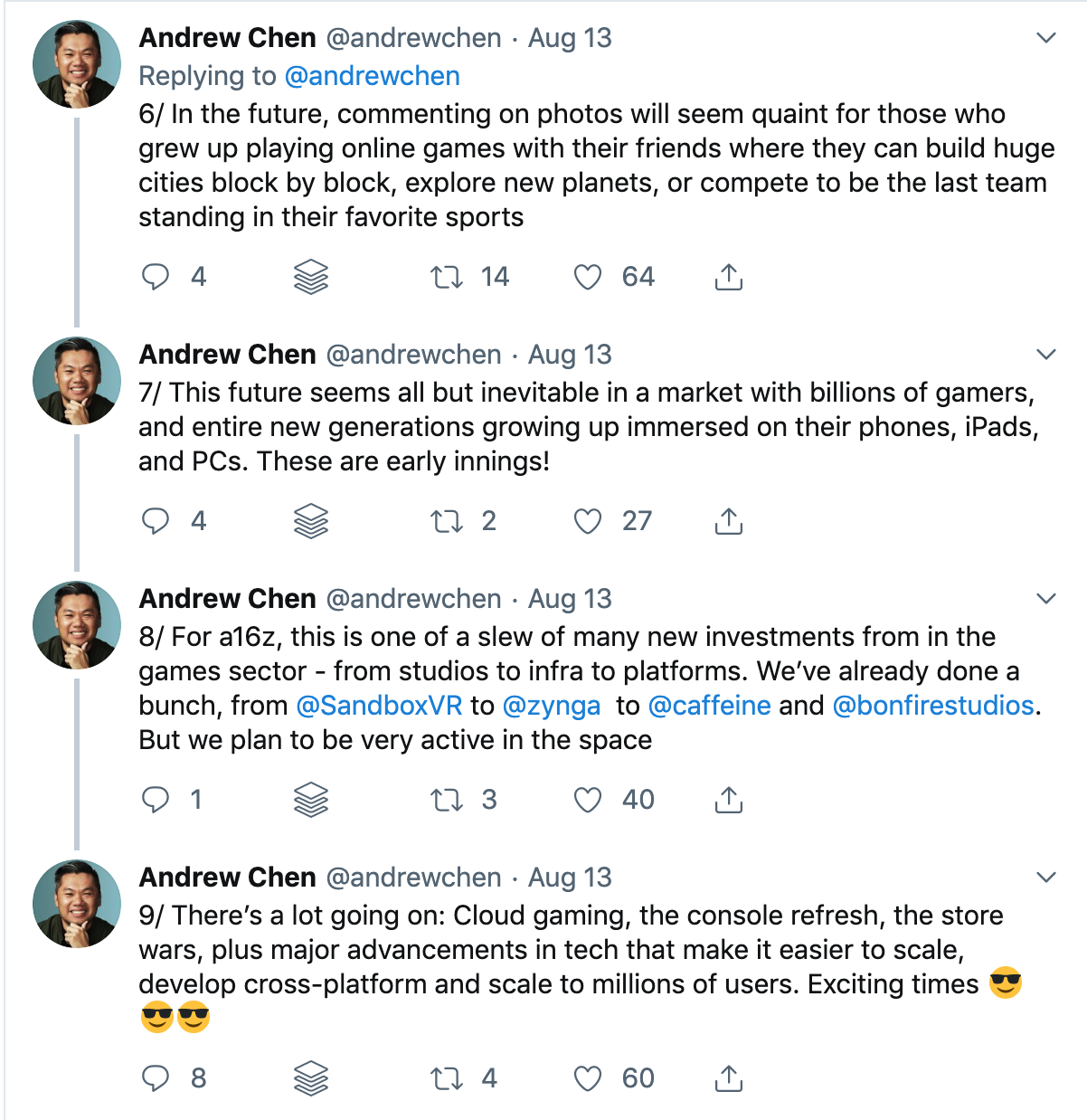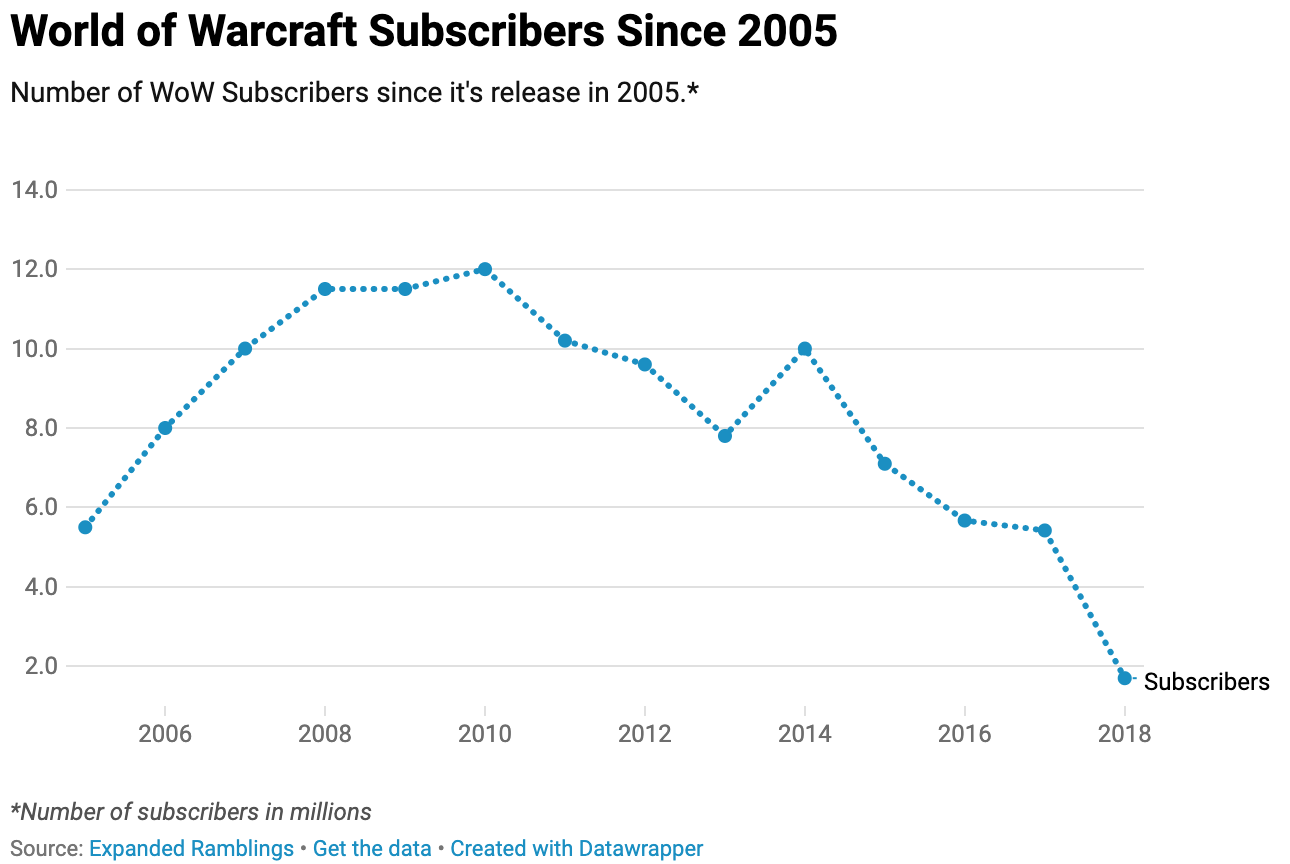Andreesen Horowitz recently announced they’ve led a $16.5 million investment in gaming company Singularity6. While I’m a huge fan of a16z in general and a big believer in the power of gaming, I am not sure Singularity6 can live up to their promises of a new social network. This is my mental thought process of why.
What is Singularity6?
Singularity6 is a video game developer that wants to create game(s?) with the mission of ‘forging alternative worlds that deepen players’ lives. In layman terms, they are creating video games where the main focus is the social aspect. I really like their overall mission – creating or deepening friendships through gaming seems to be a net positive for everyone involved.
Andrew Chen was the lead investor at a16z for the deal, and he described his reasoning behind his investment in a tweet storm.

His argument is that digital interactions have always changed in technology, and this time will be no different. Andrew gives the examples of AOL chatrooms, Yahoo Groups, and now products with feeds and photos. The next evolution? Games.
This makes a lot of sense to me. I know they aren’t truly dimensions, but I’ve viewed these changes as moves up the dimensionality ladder. To me, the chatrooms of the past represented a 2D experience. By using a chatroom people were able to send texts from one point to another, creating a line (2D). The social media that we have today is what I would call 3D-. It mimics three dimensions, but doesn’t quite achieve it.
Text is something we experience in two dimensions. We identify letters by how they curve up and down, but there is no third dimension that aids our understanding. Pictures simulate three dimensions because the color and shapes allow our minds to understand the context of the picture. But pictures are still a 2D experience because a picture is a plane. We can zoom into a picture, but we can’t travel through a picture. You could call it either 2D+ or 3D-, but I prefer 3D- because it simulates something without replicating it.
A video game is a 3D experience. You see a picture through a screen, but you can travel within the world displayed. Every square is a rectangle, but not every rectangle is a square. Similarly, every 3D experience is a 2D one, but not every 2D experience can be a 3D one. I agree with Andrew Chen that social has evolved with technology because I believe we struggle to embrace an old reality when a new one is just better. Black and white TV? Great for nostalgia, but no one would suggest reverting to black and white again.
Sometimes though, it’s hard to accept change. I tend to agree with Everett Rogers’ five stages of adoption, and think we are currently in between the early adopter and early majority stages. Once we reach the late majority tipping point, accepting video games as the new norm will be inevitable.

So I agree with Andrew Chen’s premise and I like the company’s vision, so why do I disagree that Singularity6 will succeed? First, I don’t quite buy that they can create the future of social by making multiple games. I also don’t think we have the technology necessary to make the shift to a true 3D experience.
Ready Player One
I’ve written at length about how amazing the video game industry is in general. It is one of the least sexy industries, and yet it outsells the movie and music industry combined, and has more revenue than television. Video games have proven time and time again that they are sticky and easily monetized, which is more than you can say for a lot of industries.
However, the beauty of video games are that they are easily replaceable and that the industry pivots so often. That’s why the anomalies like World of Warcraft (WoW), Starcraft, Counter Strike Global Offensive (CSGO), and League of Legends are so impressive. They have lasted for decade(s) while some of the largest franchises to date require yearly releases (Call of Duty and Grand Theft Auto come to mind) to retain customers.
But even the behemoths come to an end. World of Warcraft peaked at 12 million paying subscribers in 2010 but is now slightly below 2 million. They kept users on the platform for so long with expansion updates, but no good thing lasts forever.

In many ways, WoW exemplifies many of Singularity6’s stated goals. A common, open world combined with player-created guilds fostered a sense of community that extended far beyond other games. Voice chat allowed people to communicate more fluidly in game and get to know one another better. If you don’t believe me, the story of Mats Steen will hopefully convince you.
Mats Steen was four years old when he was diagnosed with muscular dystrophy (DMD), a rare genetic condition that causes muscle degeneration. Most people diagnosed fail to live past 20 and experience a relatively low quality of life. While his parents grieved that he would never live a normal life, Mats created a new one for himself on WoW. He didn’t have many ‘real-life’ friends because he was never able to go outside and play with other kids, but he didn’t have a wheelchair online.
Mats Steen died at 25 years old, but he didn’t die friendless like his parents expected. His guildmembers raised funds for those who could travel to his funeral, and they came from countries across the world. Guildmembers from the Netherlands, UK, Finland, and Denmark came for Mats’ funeral in Oslo.
You can find the full tear-wrenching story here. Mats’ experience on WoW is not unique, there were many people that cared deeply for one another who never met in person. But WoW has not replaced social media, and it never will.
So how can Singularity6 make the future?
I believe that one game alone will not be able to replace social media today. Neither will multiple games – if you have to continually switch between games you’ll never be able to make a dedicated community. But if you create an open world game that can house other games? Then I think you have a recipe for success.
What do I mean by an open world game that houses other games? I’m thinking of a game that resembles Ready Player One. For those who did not read the book or watch the movie, there is a game called the Oasis where people can create their digital avatars. They can interact with other players in the Oasis and choose to play a variety of games either solo or with their friends.

The reason I believe this would succeed in the future is because it includes the community-building aspects that made WoW so powerful while taking into account the ephemeral nature of video games. People always want to try the next best thing in gaming, but I believe they want to hold on to their personas for long periods of time.
I’m imagining that Singularity6 would partner with developers like Activision Blizzard or Treyarch to provide games to be attached to their platform. Singularity6 would essentially create the ‘Oasis’, and traditional game developers would add the games that players would jump into. These games could be paywalled – meaning that you would still pay Activision/Treyarch to have access to the games – which allows the partnership to function.
This way new games would not entice users to leave the platform. Rather, they would add another reason why to never leave. People’s digital characters would carry a record of their achievements in all the various side games while within the Oasis, which would allow for people to compare their stats with friends and strangers.
Instead of sharing pictures on Instagram, you could share clips of your gameplay on Singularity’s mobile app. You could replace direct messages with in game pings that could be sent on the platform or over mobile. If one of your friends is playing a game, you could click a button in your chat to quickly enter a live stream of their gameplay. Sharing becomes seamless between platforms and you could build an entirely new identity online.
I believe this kind of system could create the new future of social, but it’s heavily gated by technology. Whether this technology will be available in the next few years or decades is yet to be seen, but I think it’s worth going over.
Futurology
The social media platforms we know today are successful because they can connect billions of people over our phones. The platforms are attractive because connection is always at our fingertips. Something funny happening on the street? Two clicks and you can post it. Want to know what your friends are up to? One tap and you’ll see a newsfeed of relevant posts. As they are now, the process of sharing video games is too onerous to have this kind of interaction.
Streaming has made it a lot easier, but many of the best games today require a lot of computing power, rendering our phones relatively useless. Fortnite has made some advances in mobile gaming (you can play relatively easily from an iPad with some modified controls), but we are a ways away from running WoW on an iPhone. Because of this, it’s really hard to believe that connecting through a game is better than what we have currently.
The greatest role playing games require an enormous amount of computing power. My favorites to date: World of Warcraft, Skyrim, Breath of the Wild (BotW), and Horizon Zero Dawn. Creating an open world is one thing, but to populate it with billions of people and NPC (non-playable characters) is another. In order to bring people from the real world into these worlds on a constant basis, we need new technology.
It’s no secret that technology has been improving at an increasing rate, so I believe this type of breakthrough is possible. But I don’t think it will come any time soon. The iPhone revolutionized portable computers, but it still took 10 years to saturate the market. And if Steve Jobs is to be believed (and I think he is), the iPhone was years ahead of its competition when it was first released. Considering that Focals by North and Google Glass have failed to take off, we’re at least a decade away from the future Singularity6 is building.
There will have to be baby steps. The game could be run on computers, but there could be a mobile version with a chat function and a place you can post clips of your gameplay. The real future comes when we develop a HUD (heads up display) that is capable of running games in real time, but that will be decades away.

So where does that leave Singularity6? They’re being rightfully secretive about their full-time goals, but I believe they’re going about it the wrong way. I think it will always be possible to capture millions of gamers, and gamers know how to make communities online. But to convince billions of non-gamers to convert? You’re going to need a lot more.
I guess you could make the case that everyone will become gamers so my point is moot, but I think that’s a less interesting argument that I can cover later. There is still hope for the old guard. World of Warcraft came out with WoW Classic today (August 26th), and there are hour long queues of people waiting for their dose of nostalgia. Maybe WoW will make a comeback, and maybe the community becomes stronger than ever. In my opinion, it’s more likely that this is just a fad and that WoW has outlived its welcome. But who knows, I didn’t think Fortnite was very fun either.
Anyways, those are my thoughts regarding a16z’s investment in Singularity6. I’m cheering for the team and their mission, but I think that they might be too early to market. I hope I’m wrong. If you have any thoughts I’d love to hear from you. You can reach me at nick@nickchua.me.